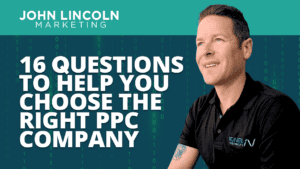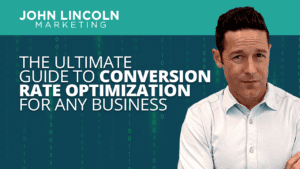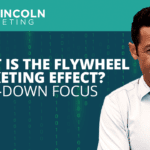
Top 16 Questions to Ask a PPC Company in 2024
In 2024, choosing the right PPC company is not just about spending your advertising budget. You want to make every cent count towards your business
We’re in the privacy era of the Information Age. As a result, you’ll need to rely on CRM marketing.
Several years ago, you could easily target people based on their interests and demographics.
But alas, nowadays, folks want to keep information about themselves as private as possible.
Understandably.
That makes things a little more challenging for you as a marketer. So you’ll need to target folks based on in-house data.
And that data comes from your CRM.
In this guide, I’ll explain how you can structure a month-by-month CRM marketing strategy during the following years.
You might not have heard the acronym CRM if you’re new to marketing. So what does it mean?
A CRM is a Customer Relationship Management tool. It’s the technology that enables you to build relationships with people in your target market so you can increase sales.
Think of a CRM as contact management software for people in sales. That’s how the concept started.
But today, a CRM is much more than a contact management system. It’s a full-blown marketing powerhouse that also:
CRMs enable you to follow the entire customer journey from pitch to purchase.
But beyond that, modern CRMs often integrate with your business’s other systems. For example, when a sales rep has closed a deal, the CRM can enter an Accounts Receivable journal entry in your accounting service.
And it does that all on its own. The sales rep doesn’t have to touch a thing.
In short, if you’re selling anything, you probably want a CRM.
Now that I’ve explained the concept of a CRM let’s go over the month-by-month structure I promised earlier.
Your overall goals are the first thing you want to think about when setting up your CRM marketing program.
It would be best if you focused on what new technology you will integrate into your plan.
Do this by mapping out your setup in a discover session. Here, discuss with your team the goals and technology you will use to make it happen.
Next, think about the best way to organize your customer database and marketing channels.
There are several ways you can do that.
One way to organize your CRM database is by tracking the customer’s entry point into your website.
Did the customer visit your site via a popup? An event? A contact form?
If the customer visited via a contact form, what step was the person in? Was it the first step or the full funnel contact form?
What kind of info did the customer enter into the contact form? A full name and address? A budget?
Further, use the contact form to gather data about whether the customer intends to purchase.
Once you’ve gathered that data, you can segment your customers into different groups using lead scoring.
If you’re unfamiliar with lead scoring, it’s qualifying people your business has contacted based on their potential to become customers.
Here are the different qualification levels:
Remember, you can take things further once you’ve identified people as customers.
Let’s say you’ve got multiple lines of business and have a customer for one of those lines. Try to market a product from another line of business to that person.
One way to identify which line of business an existing customer has worked with is by using a tagging framework.
Almost all CRMs nowadays include a tagging framework. It’s a system that lets you “tag” a person in any way you want.
The tag is usually short text. For example, if you’re marketing sportswear, you can tag a new customer who bought a shirt with the word “shirt.”
In the future, you might want to market your running shoes to people who’ve already purchased shirts. In that case, you’d filter your CRM database with people with the tag “shirt” and use that group as your audience for the campaign.
You can use your CRM database to identify people based on other characteristics, such as:
As you can see, that’s a lot of data to track. That’s why you’ll need to enlist the aid of tools to follow it.
By the end of the second month, you’ll have your tech stack and strategy in place.
Start building your database.
Customers visit your website. You gather data from contact forms. You track those customers as they navigate around your website so you can determine their interests.
And now you can move those customers towards your overall goal: increasing customer lifetime value with the number of products and services they’re buying.
You’ll also want to identify your best customers so you can sell them more.
And it’s during this time that you’ll start using scenarios.
What’s a scenario? It’s a way of framing where a customer is at a specific time during the sales journey.
For example, let’s say a customer went through the checkout process on your ecommerce site, making it to the last step.
Depending on the data you’ve gathered about that customer and other customer behavior patterns, you have a couple of options:
But the message you’ll send is more important than how you reach your customer.
Designing a hypothesis is one way to develop the right message for a specific scenario is to design a hypothesis.
Continuing with the example of the customer above, maybe your analytics tells you that when people stay on the last page of the checkout process for four seconds, there’s a 90% chance they’ll exit buying nothing.
So your hypothesis in that scenario might be: offering a 5% discount to the customer will increase the likelihood of conversion.
Now use your tech stack to put that hypothesis to the test.
Another hypothesis for the above scenario: hit them with fear of loss. Show a popup telling the customer only three products are left in stock.
Once again, put that hypothesis to the test.
Those efforts at nudging the customer to complete the purchase process can make all the difference.
As a rule of thumb, it’s a great idea to deploy one new scenario per business line per month.
After the first month, you’ll need to check your analytics and evaluate your scenarios. Get rid of the ones that don’t perform and keep the ones bringing home the bacon.
By the end of Month 4, you should have at least one or two scenarios in place.
During this time period you should start running reports on your initial scenarios.
Pro-tip: any digital marketing tool worth the money will include reporting. Use those reporting components to determine if your hypothesis was accurate.
You’ll also want to launch at least four more scenarios.
By now, you’ve formalized the scenario framework.
You’ll find that new scenarios trickle in. You’re running new tests on past scenarios. And you’re gathering reports from test results.
In other words, you’ve got a self-improving framework of scenario deployment through multi-channel digital marketing.
During this mature phase of your strategy, you’ll also look at other ways to optimize your site and reach customers.
Evaluate metrics including:
And you can break those stats down further by device or location.
There you have it. A simple, year-long framework of marketing to people using first-party data you’ve collected with the aid of your CRM.
Why not get the ball rolling today if you’re running a business and have done little with CRM marketing?
Start by evaluating different tools. Pick the one that’s right for your business. And then follow the steps above.
Welcome to John Lincoln’s personal website. You can learn about John Lincoln’s books, films, book him to speak and contact him. John is directly associated with many of the businesses mentioned on this website and freely discloses this information.

John Lincoln is CEO of Ignite Visibility, one of the top digital marketing agencies in the nation. Ignite Visibility is a 6x Inc. 5,000 company. Ignite Visibility offers a unique digital marketing program tied directly to ROI with a focus on using SEO, social media, paid media, CRO, email and PR to achieve results. Outside of Ignite Visibility, Lincoln is a frequent speaker and author of the books Advolution, Digital Influencer and The Forecaster Method. Lincoln is consistently named one of the top digital marketers in the industry and was the recipient of the coveted Search Engine Land “Search Marketer of The Year” award. Lincoln has taught digital marketing and Web Analytics at the University of California San Diego since 2010, has been named as one of San Diego’s most admired CEO’s and a top business leader under 40. Lincoln has also made “SEO: The Movie” and “Social Media Marketing: The Movie.” His business mission is to help others through digital marketing.
Want to get in touch with John Lincoln? Click Here To Reach Out.

In 2024, choosing the right PPC company is not just about spending your advertising budget. You want to make every cent count towards your business

Whether you’re a seasoned marketer or just starting out, conversion rate optimization (CRO) is a powerful tool that can boost your sales, leads, and overall

Feeling overwhelmed by the sea of SEO companies out there? You’re not alone! Choosing the right partner is crucial for achieving your online marketing
 What Is the Flywheel Marketing Effect? A Top-Down Focus
What Is the Flywheel Marketing Effect? A Top-Down Focus At one time, you may have encountered an executive who spoke favorably about “The Flywheel Effect.”But what exactly is Flywheel